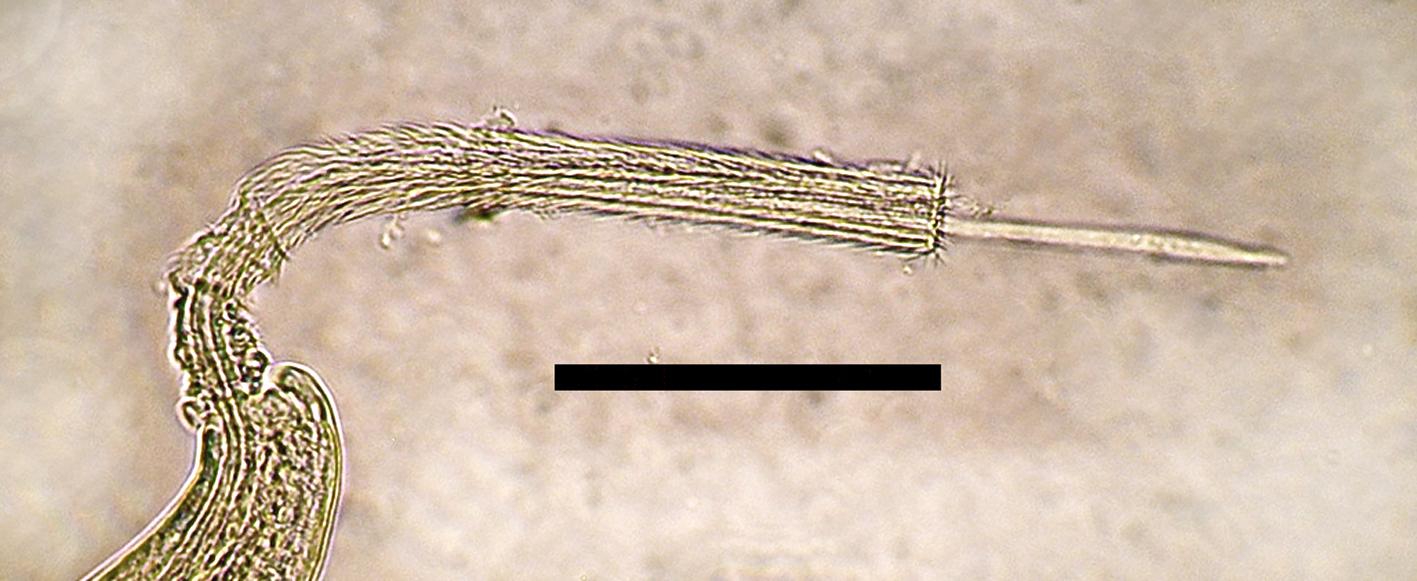|
Trichuris Ovis
''Trichuris ovis'', commonly known as a whipworm, is a nematode belonging to the genus '' Trichuris''. This whipworm species was first discovered in 1795 and is known to infect sheep and goats. These organisms are capable of inhabiting any region that has the aforementioned hosts, as can be attested by the numerous reports of ''T. ovis'' findings throughout North and South America, Australia, Europe, and Asia. Information regarding the species' general life cycle and egg development can be seen in the '' Trichuris'' page. Morphology This species of whipworm is white and is known to have a long, thin neck that composes two-thirds of its body, and a short, thick posterior. The male organisms of ''T. ovis'' usually range from 53.04mm-75.08mm in length, while their female counterparts are approximately 32.03-70.19mm in length. The spicule length is 4.18-5.62mm for both genders. Both genders also have bacillary bands. ''T. ovis'' that inhabit different species of sheep or goats can ha ... [...More Info...] [...Related Items...] OR: [Wikipedia] [Google] [Baidu] |
Trichuris
''Trichuris'', often referred to as whipworms (which typically refers to ''T. trichiura'' only in medicine, and to any other species in veterinary medicine), is a genus of parasitic worms from the roundworm family Trichuridae, which are helminths. The name whipworm refers to the shape of the worm; they look like whips with wider "handles" at the posterior end. The name ''Trichocephalus'' is sometimes used for this genus. Species The genus ''Trichuris'' includes over 20 species, which infect the large intestine of their host, including: * '' Trichuris trichiura'' (sometimes ''Trichocephalus trichiurus'') – causes trichuriasis in humans * '' Trichuris campanula'' (cat whipworm) * '' Trichuris serrata'' (cat whipworm) * '' Trichuris suis'' (pig whipworm) * '' Trichuris muris'' (mouse whipworm) * '' Trichuris vulpis'' (dog whipworm) A new species – as yet unnamed – has been identified in François’ leaf monkey ('' Trachypithecus francoisi''). Other species in this genus i ... [...More Info...] [...Related Items...] OR: [Wikipedia] [Google] [Baidu] |
Trichocephalida
The Trichocephalida (Trichinellida or Trichurida in other classifications) is an order of parasitic nematodes. Taxonomy The order Trichocephalida includes, according to modern classifications, the single suborder Trichinellina Hodda, 2007, which itself includes the single superfamily Trichinelloidea Ward, 1907, which itself includes 6 families: * Family Anatrichosomatidae Yamaguti, 1961 (1 genus, 5 species) including the single genus ''Anatrichosoma'' * Family Capillariidae Railliet, 1915Railliet, A. 1915: L'emploi des médicaments dans le traitement des maladies causées par des Nématodes. ''Recueil de Médecine Vétérinaire, Paris,'' 91, 490–513. ot seen/ref> (1 subfamily, 18-22 genera according to classifications,Moravec, F. 2001: Trichinelloid Nematodes parasitic in cold-blooded vertebrates. Academia, Praha, 432 pp. (list of genera of Capillariidae in pages 30-32) () 390 species) including ''Capillaria'' * Family Cystoopsidae Skrjabin, 1923 (2 subfamilies, 2 genera ... [...More Info...] [...Related Items...] OR: [Wikipedia] [Google] [Baidu] |
Parasitic Nematodes Of Mammals
Parasitism is a close relationship between species, where one organism, the parasite, lives on or inside another organism, the host, causing it some harm, and is adapted structurally to this way of life. The entomologist E. O. Wilson has characterised parasites as "predators that eat prey in units of less than one". Parasites include single-celled protozoans such as the agents of malaria, sleeping sickness, and amoebic dysentery; animals such as hookworms, lice, mosquitoes, and vampire bats; fungi such as honey fungus and the agents of ringworm; and plants such as mistletoe, dodder, and the broomrapes. There are six major parasitic strategies of exploitation of animal hosts, namely parasitic castration, directly transmitted parasitism (by contact), trophicallytransmitted parasitism (by being eaten), vector-transmitted parasitism, parasitoidism, and micropredation. One major axis of classification concerns invasiveness: an endoparasite lives inside the host's body; an ect ... [...More Info...] [...Related Items...] OR: [Wikipedia] [Google] [Baidu] |
